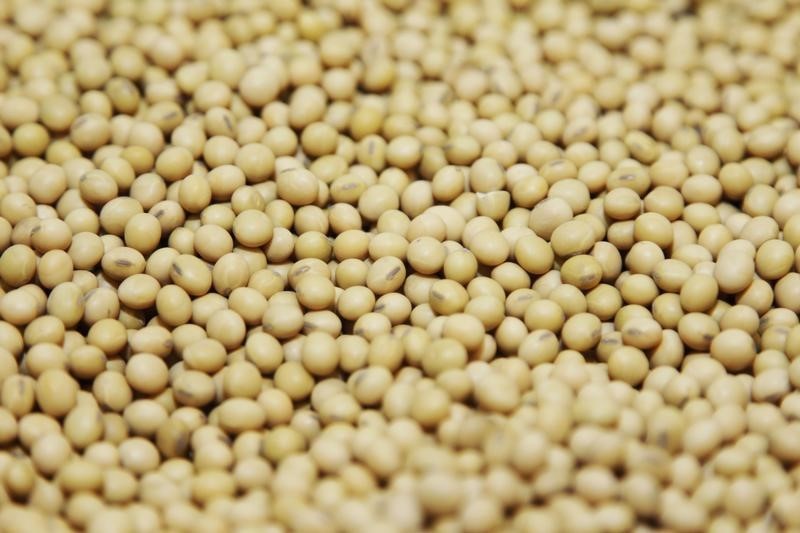By P.J. Huffstutter and Carey Gillam
CHICAGO AND KANSAS CITY XX (Reuters) - With its shares trading at three-year-lows since it abandoned a $46 billion bid to buy Syngenta AG (SIX:SYNN) last month, Monsanto (NYSE:MON) Co. plans to offer worried shareholders a new corporate vision: a future in big data.
Monsanto executives are repositioning the company as a business built on data science and services, not just chemicals, seeds and genetic traits, Monsanto's chief technology officer Robert T. Fraley told Reuters. The company's top executives are sketching plans now, briefing top shareholders at all ahead of a November investor meeting at the company's St. Louis headquarters.
Fraley and others in recent months have met with at least 195 tech start-ups and identified five as potential acquisition targets, pending Monsanto's testing of products they make, company sources said.
But the ags-data field is crowded, and Monsanto's experience from its 2013 acquisition of Climate Corp. raises questions about the company's goal to reach profitability in its ags-data by 2019. The shifting narrative also is a sharp departure from the vision Monsanto described just weeks ago, as it bid for Syngenta, of a future based on agricultural chemicals and high-tech seeds.
"We transformed from industrial chemical company to a biotech company, then to a seeds company," Fraley said. "Now, we're transforming again."
Ultimately, Monsanto's aim is to cut its operational costs, improve its return on existing investments, and develop lucrative new product lines. Work already under way includes tools that improve planting efficiency, sensors that help Monsanto track its seeds shipped in cargo containers, and computer modelling that can speed the rollout of new seeds and traits while still reducing Monsanto's own staffing costs.
Company officials decline to project the sales and profits they expect from the move into high-tech tools and services. Monsanto also is unclear how its on-farm data offerings might fare in a competitive U.S. market.
Farmers and agribusiness customers so far have been reluctant to pay for data services, particularly with farm income down by half since its 2013 high.
Sam Miller, head of agriculture banking at BMO Harris Bank, said farmers, especially large producers, are looking for data services. But the competitive landscape is fierce among Monsanto and rivals Syngenta , Dupont Pioneer, WinField Solutions and others.
The companies "are all talking to these producers about their data services," Miller said.
SELLING ITS VISION
Since Monsanto dropped its bid for Syngenta on Aug. 26, both companies have rushed to appease shareholders unsettled by the failed takeover effort. Both are conducting stock buybacks. Syngenta also plans to speed the sale of its vegetable seeds and has said its research pipeline has 15 new crop protection products with a potential $6 billion in annual sales.
This is not the first time Monsanto has touted data services. The company in 2012 paid $250 million to buy equipment maker Precision Planting, and in 2013 Monsanto paid $970 million for weather forecasting firm Climate Corp.
Chief Executive Officer Hugh Grant in 2013 year cited a "big change" and stated data was one of two new platforms for growth, along with biological research in crop protection. Since then, Monsanto told Reuters, its biologics and data efforts have taken a larger overall bite of the company's more than $1 billion in annual R&D spending in recent years.
Securities analysts are skeptical of the shift in vision.
"There's a big difference between profits and meaningful profits that will move the needle," said Matt Arnold, an equity analyst with Edward Jones. "We would not expect [data services] to be a needle mover in the near future."
Climate Corp. has shown signs of promise. But so far, there is little evidence that the venture can help Monsanto conquer a $20 billion market, with its products ranging from precision planting sensors, to weather and planting forecasts, to wireless data devices and soil analysis services.
Climate Corp.'s free offerings are used by farmers or consultants on 22 percent of U.S. cropland, or 75 million acres. But only 1.5 percent of U.S. farmland is tilled by people who have agreed to pay for Climate's data services, the company said.
"I like what I see, but I like it more because it's free," said Thomas Bonnster, a Midwestern crop farmer, while touring Climate Corp.'s booth at a recent farm show near DeKalb, Ill.
Monsanto officials acknowledge Climate Corp. must find more paying customers, but declined to say how many more it needs.
Monsanto's rivals have taken different approaches in their own efforts to earn profits from Big Data. Bayer CropScience's digital strategy is focussed on applying data to improve agrichemicals products the company sells to farmers, company officials told Reuters.
"We make money the old-fashioned way: Selling those [chemical] products," said Bayer CropScience chief executive Jim Blome.
CNH Industrial charges for its farming and land-management services, but a spokeswoman said farmers still own the data they generate.
CHANGING TIMES
Monsanto's attempted pivot comes as longtime profit stalwarts—the weed killer Roundup and the company's portfolio of genetically modified seeds—both are showing signs of strain. Roundup's longevity as a farmer mainstay has become vulnerable as weed resistance to its active ingredient glyphosate has grown.
Monsanto is moving towards a Roundup successor, ramping up production of weed killer dicamba, and seeds tolerant of both glyphosate and dicamba. But rival Dow AgroSciences has created alternative herbicide-tolerant crops and a newer herbicide to compete with Monsanto.
The strong dollar and sluggish commodity prices are adding to Monsanto's woes.
The company's 2015 fiscal third quarter showed the strain. During the quarter, Monsanto announced a deal with Scotts Miracle-Gro Co that boosted profits by $274 million. Without that one-time boost, Monsanto's crop protection and herbicide segment--dominated by glyphosate--would have seen a 16 percent drop in gross profits, according to regulatory filings.

Monsanto has warned that its company-wide fourth-quarter results on Oct. 7 will be break-even, and gross profits from its seeds and genomics businesses were expected to be flat year-over-year for fiscal 2015, too.